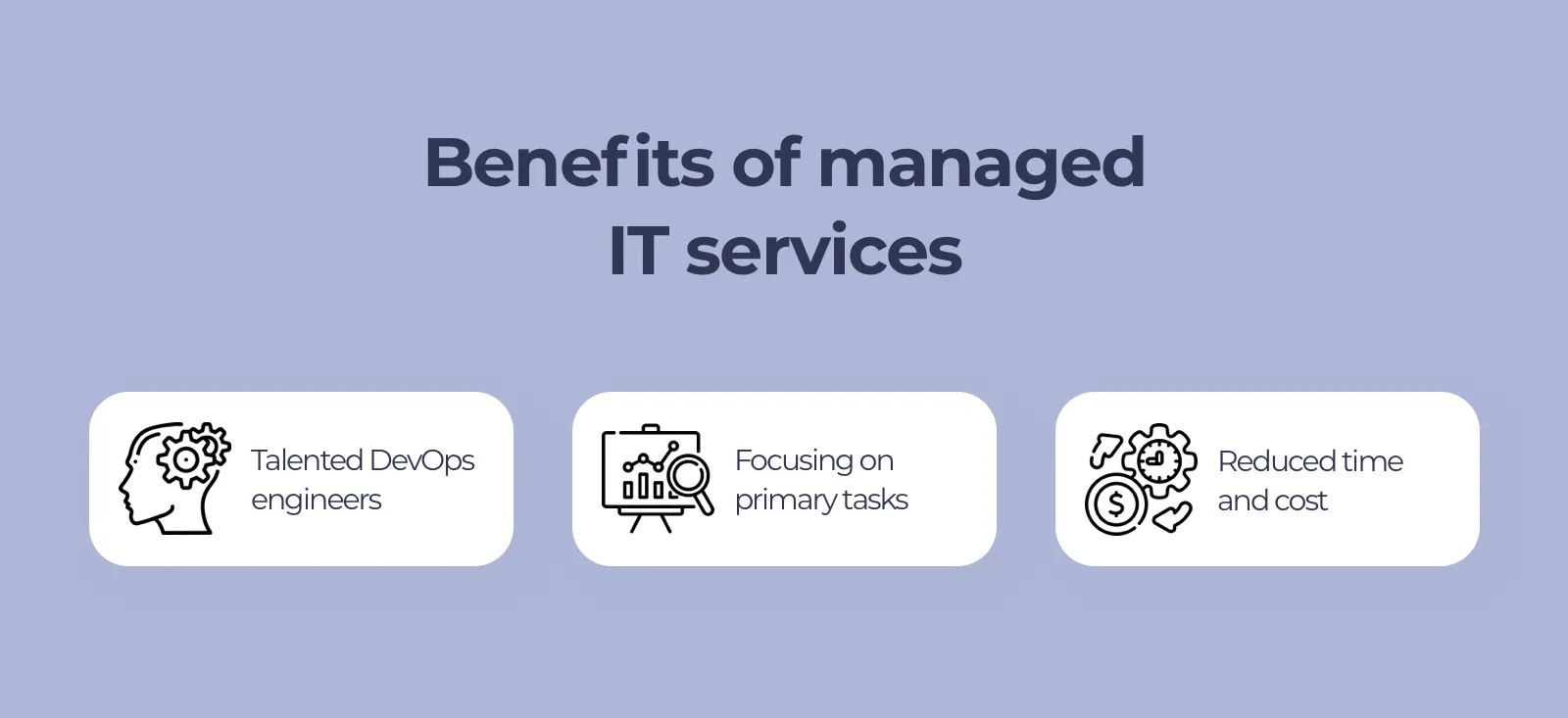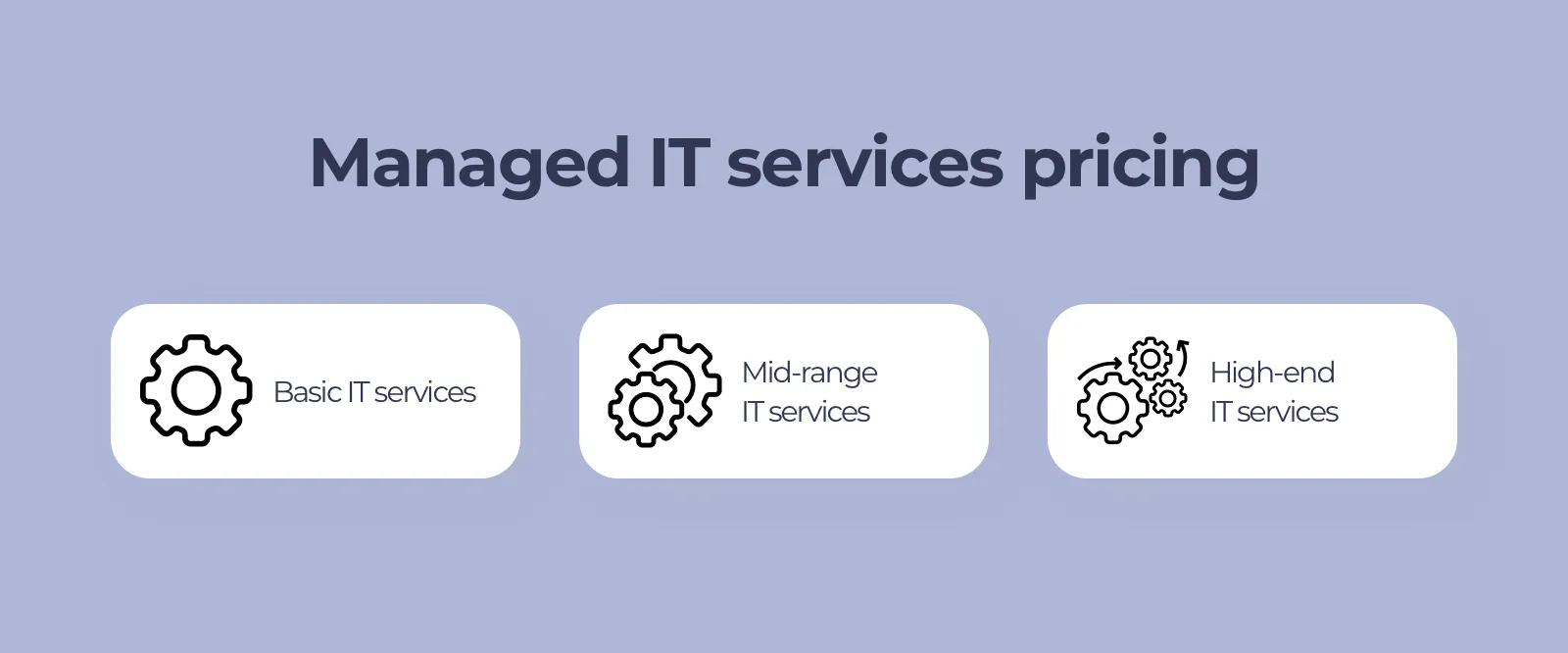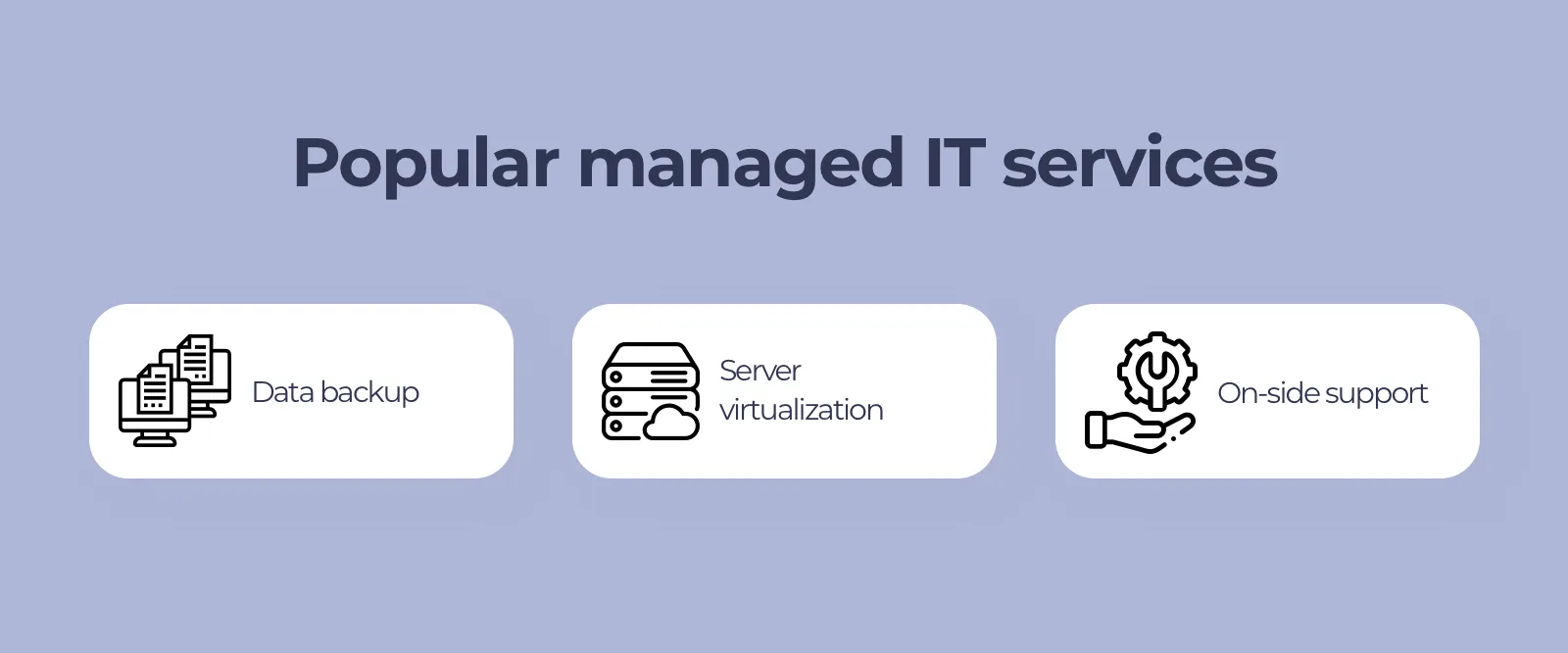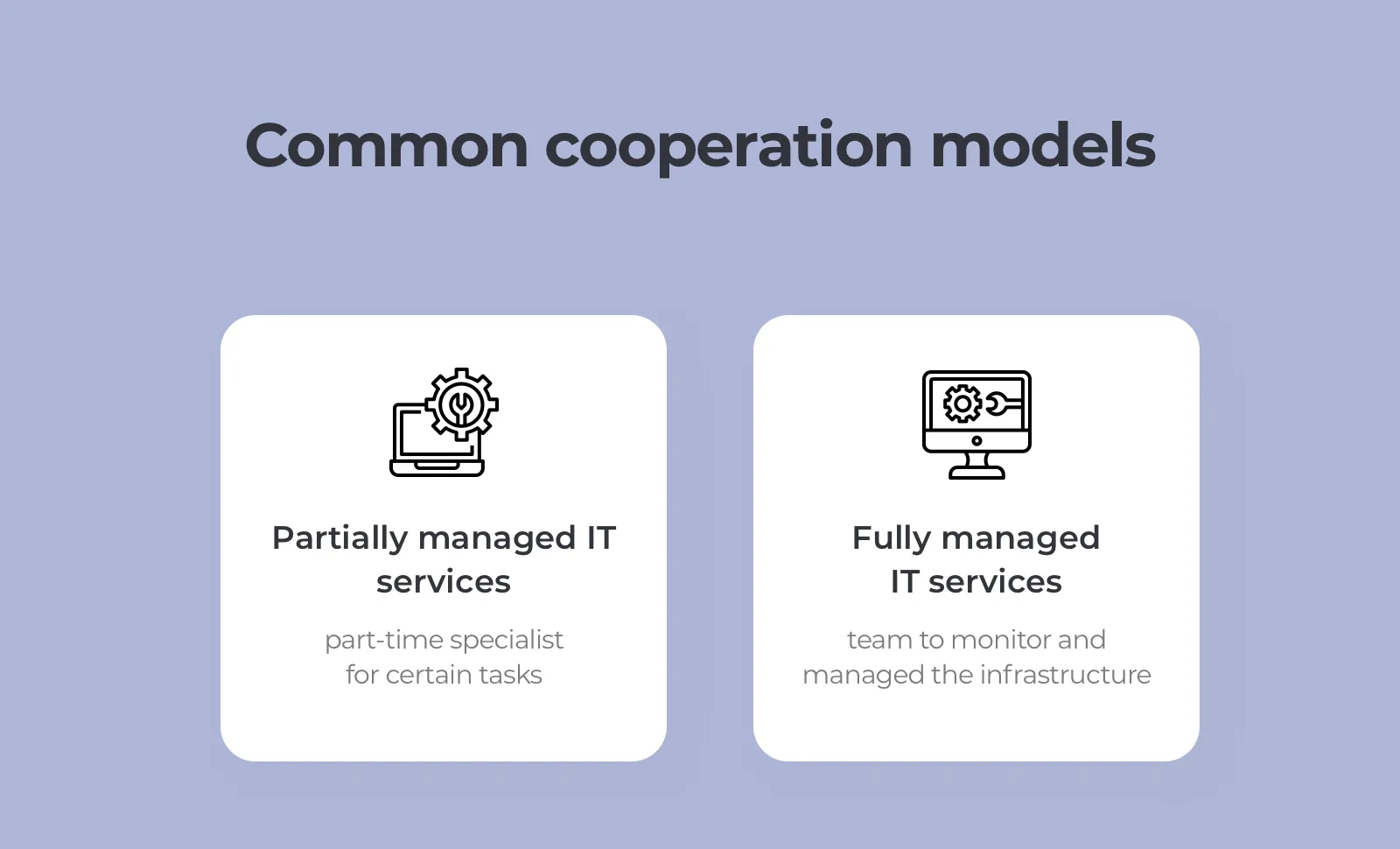Cost of Managed IT Services: Price Driving Factors and Types of Agreements
Updated 12 Mar 2023
8 Min
2379 Views
Tech solutions are becoming more complicated and need attention to every detail. To build a robust and stable project, it’s common to migrate to the cloud. Such a solution is beneficial for business since it leads to cost reduction on equipment and performance.
To maintain the cloud, your company needs skilled and experienced DevOps engineers. However, it can be challenging to find qualified specialists in a short time. To hire skilled specialists in short terms, organizations often entrust managed software development services. According to Statista, this market will go over $300 billion by 2025.
So, how much does managed IT services cost? In this guide, we’ll discuss the factors that impact managed IT services pricing and take a closer look at typical managed IT service agreements.
Explaining Cost of Managed IT Services
Managed IT services refer to handing over infrastructure-related tasks to a third-party company. Those companies take care of cloud infrastructure management, data backups, cybersecurity needs, and many other aspects.
Managed IT services offer a bunch of benefits:
- Access to the pool of talented and experienced DevOps engineers.
- Development team can focus on the primary tasks.
- Reduced time and cost (there’s no need to pay a full-time developer if you don’t have enough tasks).
What is a managed IT service? We’ve already conducted an in-depth analysis of its concept, types, benefits, and drawbacks.

Why do you need managed IT services?
A lot of companies migrate to the cloud to become more scalable. Remote work makes businesses transfer data and applications from physical servers to the cloud.
Cloud based application development allows for scaling the capacity up and down to meet the demand. For example, if there are few visitors to the website or app, you can pay less respectively. But if there are many visitors (and the company hasn't foreseen this situation), the physical server will simply go down. The cloud offers to dynamically increase the space. As a result, you don’t lose money and clients.
In 2020, Emirates Group successfully migrated both its e-commerce and corporate platforms, including over 30 business-crucial applications, from more than 250 servers to Amazon Web Services (AWS).
The migration covered the airline's customer-facing systems, it’s main booking engine, customer websites, and mobile apps. A bunch of applications were optimized to work with the modern operating system.
Now, Emirates’ Internet Booking Engine responds faster, finishing the transaction 12 seconds faster. Mobile apps also work quicker — search results are returned 5 seconds faster.
According to the Gartner report, there are three obvious leaders in cloud computing — Amazon Web Services (AWS), Microsoft Azure, Google Cloud Platform (GCP).
What Stands Behind Managed IT Service Pricing
Managed IT service pricing depends on your tech requirements and business goals. A lot of outsourcing software development companies offer useful cooperation, defining what is staff augmentation services. It means that you hire a required specialist to fulfill your tasks, meeting certain deadlines.
Learn the difference between staff augmentation vs. outsourcing. I’ve already covered pros and cons of each cooperation model.
Basic IT services
These services include basic monitoring of your systems and cost around $70-150 per month. In this case, the service provider just monitors your system’s performance and notifies you if there are some problems. You can pick basic IT services, if there’s an in-house team to maintain the infrastructure.
Mid-range IT services
Of course, mid-range managed IT services cost is higher but you get more benefits. You hire a team or an engineer (depending on your requirements) to monitor and prevent the system from going down. Moreover, in case of any tech issues, the team helps solve them. Mid-range IT services price depends on the amount of users or number of devices. Typically, it ranges from $50 to $200 per user per month.
High-end IT services
You need high-end IT services only if you require a fully hosted and cloud system. The IT service provider offers you the majority, or the entire infrastructure. A fully hosted service may cost more than $300 per user per month.

Managed IT services pricing
Popular Managed IT Service
Data backup
Security means a lot to project success. It’s common to back up the information in the cloud. If the business manages various data (like e-commerce solutions with a big database of customers), the absence of backup can result in losing money and clients. However, it’s possible to create a system that backs up information automatically. Of course, such a solution affects managed IT service pricing.
Server virtualization
It stands for the process of dividing a physical server into multiple isolated virtual servers utilizing a software application. Each virtual server tends to run its own operating system independently. This server is a hosted server managed by your IT company. Server virtualization has several benefits like high availability, reduced operating costs, and increased app performance.
On-site support
Startups don't usually have enough expertise in organizing cloud infrastructure. That’s why it’s common to outsource managed IT services. Pricing depends on the amount of work done. For example, DevOps engineers can analyze the system and offer improvements. It’s also possible to increase your system performance due to the lower consumption of resources (like using AWS).
Want to learn the price?
Contact us to discuss your project and get consulted by an experienced DevOps.

Common managed IT services
What Cooperation Models Are There?
You basically have two cooperation options with a managed IT service provider. They are part time and full time.
Partially Managed IT Services
This approach is perfect for companies that already have in-house specialists working with infrastructure, but they want to hire another expert to deal with specific tasks part time. So, they can hire a dedicated DevOps engineer that’d pay several hours a day or a week to their tasks.
A lot of IT outsourcing companies, including Cleveroad, offer partially managed IT services. It’s a handy option that lets you reduce costs as you don’t hire a full-time specialist for a part-time task.
When to choose partially managed IT services:
- You already have an in-house team.
- You require a specialist with specific knowledge and expertise.
- You have a part of work that needs to be done meeting a deadline.
DevOps outsourcing explained: how it works, reasons to outsource, and how much it can cost.
Fully Managed IT Services
For most small and middle-sized companies, it’s more reasonable to outsource managed IT services completely.
A qualified service provider can help you decide what kind of specialists you need and what type of work should be done. With no need to spend time and money on hiring employees in-house, you can significantly reduce operational expenses.
With fully managed IT services, you get a specialist working as a part of your team.
When to choose fully managed IT services:
- You don’t have in-house specialists to manage the system.
- You need expert advice on building and handling systems.

Popular cooperation models
How Much Does Managed IT Services Cost?
The cost of managed IT services can differ. So, the question arises — what are the main factors driving the cost?
- Project complexity. Let’s face it — complicated projects cost more. Developers need more time to support and maintain the required functionality, not talking about a higher qualification.
- Development team. There are two options to get managed IT services — hire in-house DevOps engineers and cooperate with a reliable vendor. The choice can depend on various factors like your requirements and business goals. Of course, the managed IT services pricing can change depending on the picked cooperation model.
- Region. Cost of managed IT services tends to vary depending on the region. For example, DevOps engineers from North America charge the highest rates in the world. On the contrary, Asian software companies have the lowest rates. But the quality of the services can be questionable.
| Region | DevOps engineer rates |
North America | $100 - $149/hr |
Australia | $100 -$149/hr |
Western Europe | $100 - $149/hr |
Asia | $49-100/hr |
Eastern Europe | $25 - $49/hr |
India | < $25/hr |
- Seniority level. DevOps engineers can be divided into three groups based on their work experience — junior, middle, and senior. The higher qualification DevOps has, the higher their rates are. Usually, middle and senior engineers have experience in various technologies and offer better solutions.
Why Outsource Managed IT Services to Cleveroad
Cleveroad is a software development company from Eastern Europe, Ukraine. For more than five years, we’ve been working with managed IT services to shorten development time.
Our DevOps engineers can help you:
- Create, adjust, support, and optimize integration and code delivery tools (Jenkins, Bamboo)
- Interact with Version Control Systems (Gitlab, Github, Bitbucket)
- Automate processes by creating scripts or using specific technologies like Ansible
- Administrate cloud platforms (AWS)
- Optimize a cloud IT infrastructure
- Integrate a required technology into a company’s IT processes
Got questions?
Contact us to share project details and get a free consultation from our DevOps engineers.
Managed IT service pricing depends on your tech requirements and business goals. A lot of outsourcing software development companies offer useful cooperation, choosing a staff augmentation model. It means that you hire a required specialist to fulfill your tasks, meeting certain deadlines.
- Data backup. Security means a lot to project success. It’s common to back up the information in the cloud.
- Server virtualization stands for the process of dividing a physical server into multiple isolated virtual servers using a software application.
- On-site support. Startups don't usually have enough expertise in organizing cloud infrastructure. That’s why it’s common to outsource managed IT services.
- Partially managed IT services. This approach is perfect for companies that already have in-house specialists working with infrastructure, but they want to hire another expert to deal with specific tasks part time. So, they can hire a dedicated DevOps engineer that’d pay several hours a day or a week to their tasks.
- Fully managed IT services. For most small and middle-sized companies, it’s more reasonable to outsource managed IT services completely. With no need to spend time and money on hiring employees in-house, you can significantly reduce operational expenses.
- Project complexity
- Development team
- Region
- Seniority level

Evgeniy Altynpara is a CTO and member of the Forbes Councils’ community of tech professionals. He is an expert in software development and technological entrepreneurship and has 10+years of experience in digital transformation consulting in Healthcare, FinTech, Supply Chain and Logistics
Give us your impressions about this article
Give us your impressions about this article